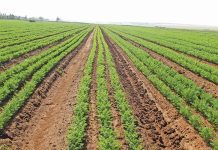The usual irrigation choices are drip, sprinkler and centre pivot, and there are pros and cons with each system. I prefer drip irrigation, which is favoured where water is scarce. There’s a huge saving when rows are far apart (especially when 5m apart) and water is placed only where it’s needed. In the early stages, young plants will draw very little water. Watering the entire area will waste water, as it will be applied to areas with no roots and will only stimulate weed growth.
The influence of rainfall
Be aware of hazards. With sporadic rain, weed growth will be limited, occurring only near the drippers. If it rains before the plants start to send out vigorous runners, weed growth will be stimulated all over. If the weeds between the rows are not mechanically or chemically removed in time, it’ll become a huge problem. Remember roots will only grow into areas with sufficient moisture. During the growth period, good rainfall could allow roots to progress unhindered. A typical prolonged dry spell can follow and the plants’ only access to moisture would be via the dripper points. The rest of the root system then becomes ineffective and prolific growth extending over the whole area creates a huge demand for water. The frequency of irrigation will have to be increased substantially so plants don’t become stressed. Plants will have to be examined daily during the heat of the day for signs of moisture stress.
Rainfall affecting feeding
During the rainy period, the extended root system gets nutrients from afar, which is then denied when dry periods set in. Watch this and ensure the plants get sufficient nourishment through drippers. This is especially important where soil fertility is not very high. In such conditions, we should initially make sure the fertiliser is applied to the dripper zones. – Bill Kerr ([email protected] or (016) 366 0616). |fw








